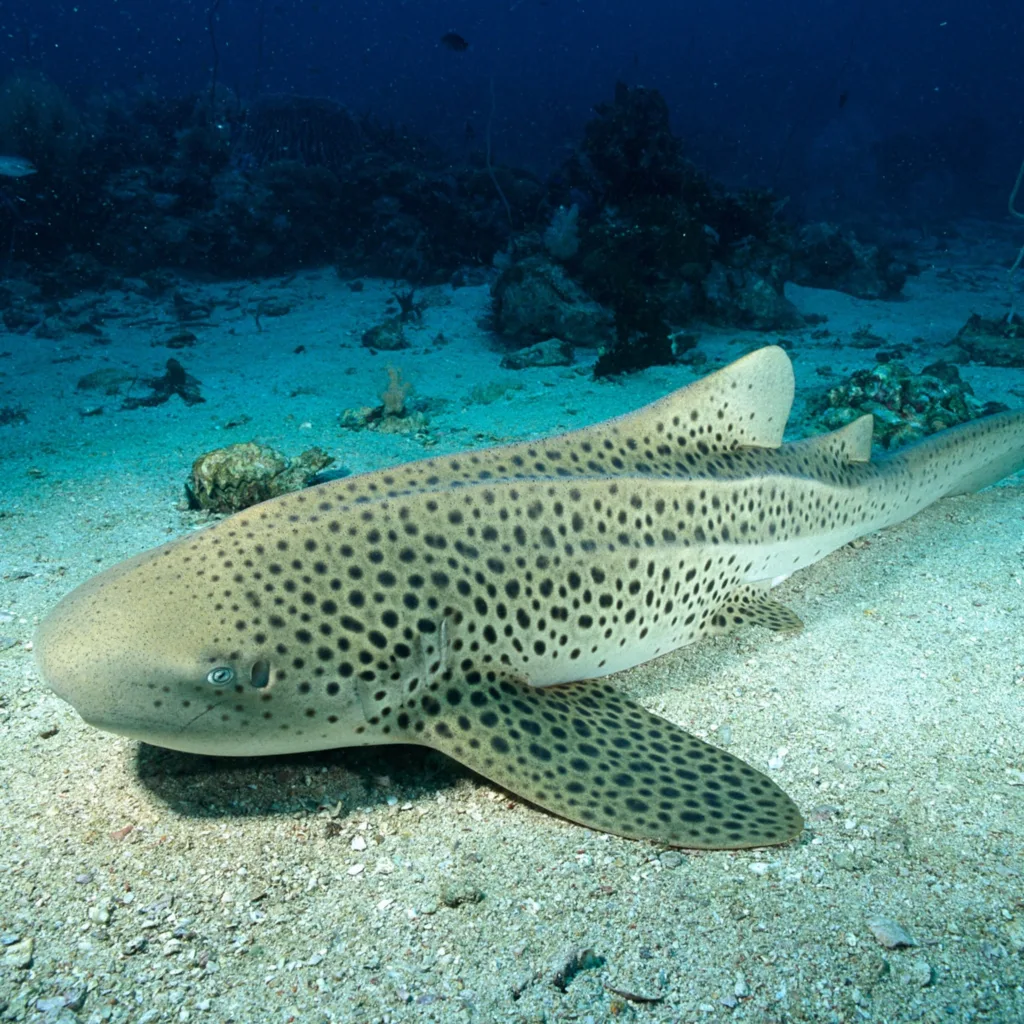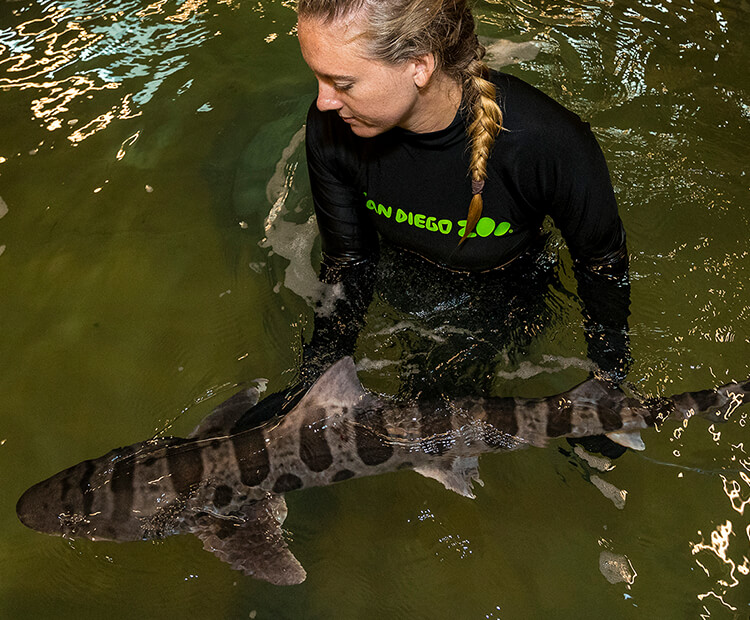Sharks are often portrayed as ruthless predators that pose a significant threat to humans. However, not all sharks are created equal, and some species are entirely harmless to humans. One such species is the leopard shark, a small, slender shark found in the Pacific Ocean. Here, we’ll take a closer look at the leopard shark, its behavior, and why it’s considered a “friendly” shark.
Leopard sharks are small, typically growing up to 6 feet in length. They have a distinctive pattern of black spots on their yellowish-brown body, which gives them their name. They have a long, slender body with a pointed snout and five gill slits on either side of their head. They have a small mouth with sharp teeth, but these teeth are not designed to bite through human flesh.
Leopard sharks are bottom-dwellers, usually found in shallow waters near the coast. They are a social species and often swim in groups, which is quite unusual for sharks. They are also relatively slow swimmers and not partiularly aggressive, making them an easy target for fishermen.
In recent years, researchers have observed some remarkable behavior among leopard sharks. They have been seen forming “social clubs” where they swim together for hours. They have also been observed making friendships and even seeking out human contact.
While it’s true that leopard sharks are not dangerous to humans, it’s important to remember that they are still wild animals. Sharks, in general, are not social creatures and don’t have the same attachment to humans as domesticated animals. It’s crucial to treat them with respect and caution.
That being said, it’s possible to have a close encounter with a leopard shark without any danger. In places like La Jolla Cove in California, leopard sharks are a common sight and are known to swim close to shore. Snorkeling or diving with leopard sharks can be a unique and unforgettable experience.
The leopard shark is a fascinating and friendly shark species that poses no threat to humans. While they may exhibit some unusual behavior, it’s essential to treat them with respect and caution. If you’re lucky enough to encounter a leopard shark in the wild, enjoy the experience but remember to keep a safe distance.
The Friendliest Shark: A Closer Look
When it comes to friendliest sharks, one species that stands out is the nurse shark. These sharks are generally slow-moving and docile, making them a popular attraction for divers and snorkelers.
Nurse sharks are known for their distinctive appearance, with a broad head and a flat, rounded body. They can grow up to 14 feet in length, but most are much smaller.
One of the reasons that nurse sharks are considered friendly is that they are not aggressive towards humans. They are not known to attack unless provoked, and even then, their bites are not usually serious.
Nurse sharks are also known for their calm demeanor. They oten rest on the ocean floor during the day and are active at night, feeding on crustaceans and small fish.
If you encounter a nurse shark while diving or snorkeling, it is important to remember to keep a safe distance and avoid touching or harassing the animal. However, if you approach them calmly and respectfully, you may be able to observe these fascinating creatures up close.
The nurse shark is considered to be the friendliest shark due to its non-aggressive nature and calm demeanor.

Can Sharks Be Friendly?
Sharks are often depicted as vicious predators in popular culture, but recent research suggests that they may have a softer side. While it is true that sharks are not traditionally thought of as “friendly” creatures, they have been observed exhibiting behaviors that suggest they are capable of forming social connections with other sharks.
One of the most fascinating examples of this behavior can be seen in a group of great white sharks that have been observed near Guadalupe Island. These sharks form “social clubs” where they swim together for hours, occasionally rubbing their noses together in what appears to be a sign of affection.
This behavior may be indicative of a more complex social structure among sharks than was previously thought. While it is true that sharks are primarily solitary creatures, they have been known to form loose associations with other sharks, particularly when hunting or mating.
It is important to note, however, that even when sharks are exhibiting friendly behavior, they are stil wild animals and should be treated with caution and respect. Sharks are powerful predators with sharp teeth and powerful jaws, and it is never a good idea to approach them too closely.
In short, while sharks may not be traditionally thought of as “friendly” creatures, recent research suggests that they are capable of forming social connections with other sharks. As with any wild animal, however, it is important to exercise caution and respect when interacting with them.
Can Humans and Sharks Form a Friendship?
Sharks are fascinating creatures that have been the subject of much curiosity and fear for centuries. While some people might be tempted to believe that sharks can be befriended, the reality is that these animals are not wired for social interactions in the way that humans are.
While it is true that some individual sharks may become habituated to the presence of humans, this is not the same as forming a friendship. Habituation occurs when a shark becomes accustomed to seeing humans on a regular basis and learns that they are not a threat. This can happen in areas where sharks are used to seeing divers or in places where they are regularly fed by humans.
However, even habituated sharks can be unpredictable and dangerous. While they may be used to seeing humans, they are still wild animals with powerful instincts and a natural drive to hunt and eat.
Moreover, sharks do not have the same social instincts as humans. They do not form bonds with othr sharks or with other species in the same way that we do. While they may have individual personalities and preferences, they are not capable of forming friendships or attachments in the same way that humans are.
While humans may be able to habituate individual sharks to their presence, it is not possible to befriend them in the traditional sense. Sharks are wild animals with unpredictable behavior, and it is important to treat them with respect and caution at all times.
Do Sharks Show Affection?
Sharks are often portrayed as vicious predators, but recent studies have shown that they are much more complex creatures than we previously thought. One question that has been raised is whether sharks can experience affection.
While it may seem unlikely that a shark could enjoy affection, some experts believe that they can. According to shark conservationist Jim Abernethy, sharks have been observed seeking out physical contact with humans, and appear to enjoy it.
Abernethy has spent many years studying and interacting with sharks, and he believes that they are capable of feeling emotions such as curiosity and even affection. He has observed sharks approaching him and seeking out physical contact, such as rubbing their noses against him or allowing him to stroke their bodies.
Of course, it’s important to remember that sharks are still wild animals, and shuld be treated with caution and respect. Abernethy emphasizes that he is not encouraging people to go out and pet sharks on their own, as this can be dangerous for both the person and the shark.
However, it’s clear that our understanding of sharks is evolving, and we are learning more about these fascinating creatures every day. While we may never fully understand the inner workings of a shark’s mind, it’s clear that they are capable of much more than we previously thought.
Are Blue Sharks a Threat to Humans?
Blue sharks are a species of shark that can be found in various oceans arond the world. They are known for their long, slender bodies, which can reach lengths of up to 12 feet. While they are not considered to be friendly, blue sharks do have a curious nature and may approach divers to investigate them.
It is important to note that blue sharks may become aggressive if they perceive a threat or if a diver is engaged in spearfishing activities. If a diver has caught something that the shark considers to be a meal, the shark may bite in an attempt to take the catch.
It is best to exercise caution when diving with blue sharks and to avoid engaging in activities that may provoke an aggressive response. If approached by a blue shark, it is recommended to remain calm and still, and to slowly back away while keeping an eye on the shark’s movements.

Do Sharks Have a Preference for Human Blood?
Sharks are often portrayed in movies and the media as bloodthirsty predators that will attack anything that bleeds, including humans. However, this is far from the truth. While it is true that sharks have a powerful sense of smell and can detect blood in the water from miles away, they do not prefer human blood over any other type of blood.
It is important to understand that sharks have evolved over millions of years to be efficient hunters and have developed a keen sense of smell to detect their prey. They are able to detect tiny amounts of blood in the water, which allows them to locate wounded or injured prey. However, sharks are not attracted to human blood specifically and do not see humans as a primary food source.
In fact, most shark attacks on humans are cases of mistaken identity. Sharks may mistake a swimmer or surfer for a seal or other marine animal that they typically prey upon. Once they realize that the human is not their preferred prey, they will usally release the person and swim away.
It is also important to note that sharks do not have a taste for human flesh. Unlike some other predators, such as lions or hyenas, who actively seek out and kill humans, sharks do not view humans as a food source, and will generally only attack if they feel threatened or provoked.
Sharks do not prefer human blood over any other type of blood, and are not actively seeking out humans as prey. While it is always important to exercise caution when swimming or surfing in areas where sharks are known to be present, it is also important to remember that the risk of a shark attack is relatively low, and that most interactions between humans and sharks are harmless.
Are Sharks More Friendly Than Dolphins?
Sharks and dolphins are two of the most popular marine creatures that people oten encounter during ocean activities. While they may look similar in terms of their streamlined body shape and their ability to swim fast, they have distinct differences in terms of their behavior and temperament towards humans.
Contrary to popular belief, sharks are not always aggressive towards humans. In fact, some species of sharks are known to be quite docile and even friendly towards humans. For instance, nurse sharks and whale sharks are known to be gentle giants that often swim close to divers without showing any signs of aggression.
On the other hand, dolphins are often portrayed as friendly and playful creatures that enjoy interacting with humans. However, this is not always the case. Dolphins are highly intelligent and social animals that have their own hierarchy and social rules. They may not always be willing to interact with humans, especially if they feel threatened or uncomfortable in their presence.
In fact, according to some divers and marine biologists, sharks can be friendlier than dolphins towards humans. These experts claim that sharks often approach divers out of curiosity and may even swim alongside them, while dolphins can be more aloof and less interested in human interaction.
However, it’s important to note that approaching any marine creature, whether it’s a shark or a dolphin, can be dangerous and should always be done with caution and respect for the animal’s space and behavior. It’s also important to remember that both sharks and dolphins are wild animals that should be observed and appreciated from a safe distance, without disturbing their natural habitat or behavior.
While sharks and dolphins may have different temperaments towards humans, it’s important to treat both of these creatures with respect and caution. Whether you encounter a shark or a dolphin during your ocean activities, always remember to observe and appreciate them from a safe distance and avoid any behavior that may be perceived as threatening or harmful.
Attraction of Sharks to Humans
Sharks are naturally curious predators, and they are attracted to their prey by various factors. In the case of humans, there are several things that can attract sharks to them. Here are some of the most common factors:
1. Blood: Sharks can detect blood in the water from miles away, and it can act as a powerful attractant. While blood alone may not be enough to attract sharks, its presence combined with other factors can make them more likely to attack.
2. Movement: Sharks are attracted to movement, especially erratic or quick movements. This is because they associate it with their prey, which often tries to escape from them.
3. Bright colors: Some studies suggest that bright colors like yellow, white, and silver can attract sharks. This is because these colors resemble the coloration of some of their prey, such as fish.
4. Splashing: Splashing in the water can also attract sharks, as it creates noise and movement that can resemble struggling prey.
5. Smells: Sharks have a highly developed sense of smell, and they can detect a wide range of scents in the water. Some smells that can attract sharks include fish oils and other strong scents.
6. Sound: some studies suggest that certain sounds, such as those produced by struggling fish or injured animals, can attract sharks.
It’s important to remember that sharks are highly sensitive to their environment and can be attracted to a wide range of factors. If you’re swimming or diving in an area known to have sharks, it’s important to take precautions and avoid behaviors that could attract them. This might include avoiding wearing bright colors, minimizing splashing, and avoiding areas with strong smells or sounds.
The Dangers of Touching Sharks
Sharks are wild animals that should always be treated with caution and respect. While it may be tempting to touch or pet a shark, it is generally not recommended. Sharks have very rough skin that can feel abrasive to the touch, and their bodies are covered in tiny scales called dermal denticles that can cause injury to human skin. Additionally, some species of sharks have sharp teeth and powerful jaws that can cause serios harm.
There are a few situations in which it may be safe to touch a shark, such as in a controlled environment like an aquarium or underwater enclosure. In these situations, trained professionals may be able to guide visitors in touching or interacting with a shark in a safe and responsible manner.
However, in the wild, it is never a good idea to touch or approach a shark. Sharks are powerful predators that can be unpredictable in their behavior, and they may perceive a human touch as a threat or an attack. This can lead to defensive or aggressive behavior, which can be dangerous for both the shark and the person.
It is important to remember that sharks are an important part of the ocean ecosystem and should be respected and protected. By keeping a safe distance and avoiding interactions with wild sharks, we can help to ensure their continued survival and protect ourselves from potential harm.

Do Sharks Have a Fear of Humans?
Sharks are often portrayed in the media as ferocious predators that actively seek out humans to attack. However, this is not entirely accurate. While it is true that some shark species have been known to attack humans, these incidents are relatively rare.
In fact, sharks are generally more afraid of humans than the other way around. This is because humans are not a natural part of the shark’s environment, and they are therefore unfamiliar and potentially threatening. When sharks do encounter humans, they often respond by swimming away or avoiding them altogether.
There are several reasons why sharks are not typically interested in hunting humans. First, humans are not a natural part of the shark’s diet. Sharks typically feed on smaller fish, squid, and other marine animals. While some larger shark species may occasionally prey on seals or other marine mammals, they are not actively seeking out humans as prey.
Second, sharks are generally not interested in humans as food. While sharks may occasionally take a bite out of a human, they usually realize that we are not a suitable food source and quickly release us. This is because humans are not high in fat or other nutrients that sharks need to survive.
Sharks are actually quite intelligent and curious creatures. They may approach humans out of curiosity, but they are not typically aggressive unless they feel threatened or provoked.
While it is important to be cautious when swimming in areas where sharks are known to live, it is unlikely that they will actively seek out humans as prey. By understanding their behavior and respecting their environment, we can coexist with these fascinating creatures and continue to learn more abot them.
The Effect of Touching a Shark’s Nose
Touching a shark’s nose can be a dangerous move, as it can trigger the animal’s electro-reception system and make it perceive you as a potential prey. Sharks have specialized organs called ampullae of Lorenzini located around their snout that can detect electrical signals in the water, including those produced by living organisms. By touching or rubbing the shark’s nose, you create a disturbance in the water that can activate these organs and case the shark to investigate or attack.
It is important to note that not all sharks react the same way to nose touching, and some may be more tolerant or curious than others. However, as a general rule, it is best to avoid touching any part of a shark’s body, especially if it is not trained or accustomed to human interaction.
If you find yourself in a situation where a shark is approaching you, it is recommended to use a hard object such as a camera, stick, or rock to push the animal away without putting yourself at risk. Additionally, you should always follow the guidelines and regulations established by local authorities and experts regarding shark encounters, and avoid swimming in areas known to have high shark activity or during their feeding times.
What To Do If Bumped By a Shark
Encountering a shark while swimming or diving can be a frightening experience, but it’s important to stay calm and take appropriate action. If a shark bumps into you, it’s crucial to follow these steps:
1. Stay calm: It’s natural to panic when something unexpected happens, but it’s important to remain calm and avoid splashing or thrashing around, as this may attract the shark’s attention.
2. Assess the situation: If the shark swims away after the initial bump, observe its behavior from a safe distance. If it appears to be circling or exhibiting aggressive behavior, it’s best to exit the water immediately.
3. Exit the water: If you can safely swim to shore or a nearby boat, do so calmly and quickly. If you’re too far from shore, get back onto your boat or oher floating device. Avoid dangling your arms or legs in the water, as this may attract the shark.
4. Check for injuries: If you’ve been bitten or scratched, it’s important to stop the bleeding by applying pressure to the wound. Seek medical attention as soon as possible, even for minor injuries.
5. Report the incident: If you’ve encountered a shark, it’s important to report the incident to local authorities or shark research organizations. This helps researchers monitor shark populations and behavior, and may help prevent future incidents.
Remember, sharks are wild animals and should be treated with caution and respect. By taking appropriate precautions and knowing what to do in the event of an encounter, you can minimize the risk of injury and enjoy a safe and enjoyable swimming or diving experience.
The Impact of Touching Sharks
Touching sharks can be harmful to them. Sharks, like many other marine animals, rely on a protective layer of bio-film to prevent infection and disease. Human contact can compromise this protective layer, leaving them vulnerable to harmful bacteria.
In addition, sharks have a highly sensitive electroreceptive system that alows them to detect electrical fields in the water. Touching them can interfere with this system, potentially causing stress and disorientation.
Furthermore, some sharks have delicate skin that can be easily damaged by touching or handling. This can lead to open wounds and infections.
It is important to remember that sharks are wild animals and should be treated with respect and caution. Touching or interacting with them can be dangerous for both the shark and the person involved.
In summary, touching sharks can hurt them by compromising their protective bio-film, interfering with their electroreceptive system, and damaging their delicate skin. It is best to observe sharks from a safe distance and avoid touching or interacting with them.

Conclusion
The leopard shark is a fascinating and friendly species of shark that poses no threat to humans. They are incredibly social creatures and can be seen swimming together in groups for hours. While they might habituate to regular divers and show affection twards them, it’s important to remember that they are still wild animals with instincts that can come to the fore at any time. Therefore, it’s crucial to treat them with respect and caution and not encourage the public to go out and pet them on their own. The more we learn about these amazing creatures, the more we realize how much there is to discover about their behavior and social interactions. The leopard shark is a reminder that not all sharks are dangerous and that we need to continue to protect and conserve these incredible animals for future generations to enjoy.
